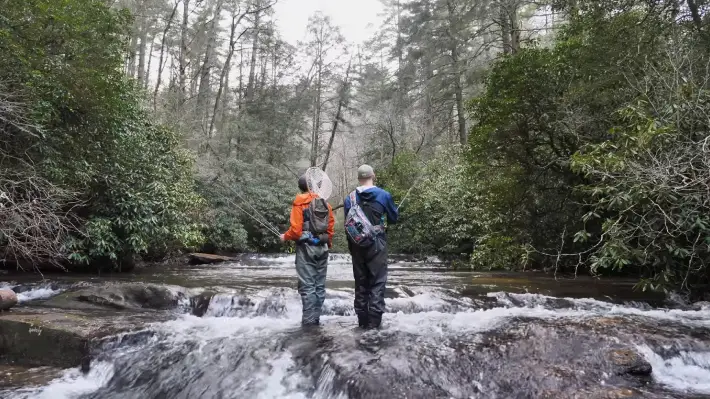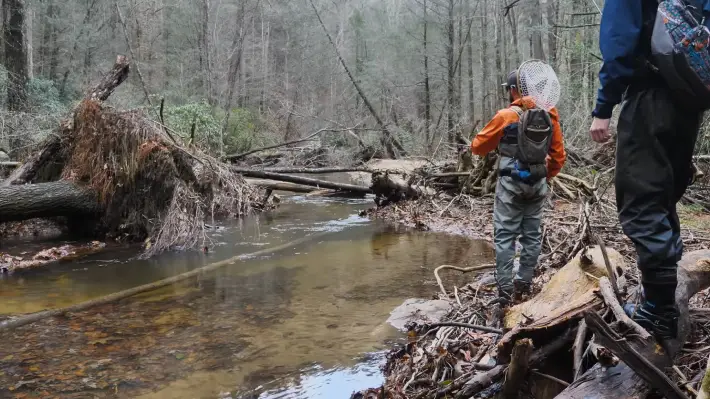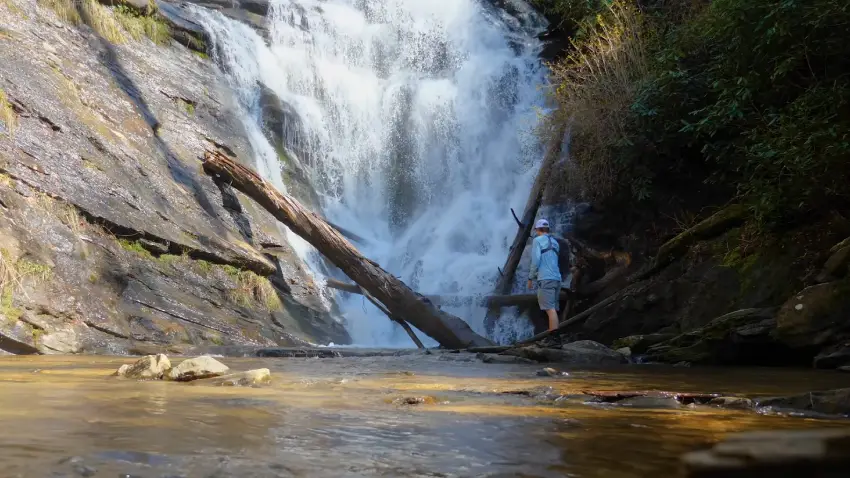Key Takeaways:
- Georgia offers a diverse range of fly fishing destinations, from tranquil mountain streams to larger rivers and reservoirs, each with its own charm.
- Fly fishing is best in Georgia from mid-March to late October or November, especially for trout.
- Anglers can fly fish in Georgia for trout (brook, brown, rainbow), smallmouth bass, redeye bass, and more.
- Several catch and release areas are designated in Georgia, promoting responsible angling and preserving fish populations.
- Rules and regulations of Fly fishing in Georgia are essential to follow. These include fishing license requirements, size and possession limits, catch and release rules, and specific time restrictions.
List of the Top Fly Fishing Destinations in Georgia

Georgia offers a diverse tapestry of fly fishing destinations, each with its unique allure and abundant fishing opportunities. Below are the top fly fishing spots in this Peach State.
- Chattahoochee River
- Cartecay River
- Chestatee River Tributaries
- Cooper Creek
- Jacks River
- Lake Rabun
- Lake Seed
- Mountaintown Creek
- Noontootla Creek
- Rock Creek
- Soque River
- Toccoa River
- Flint River
- Etowah River
- Tallulah River
- Lake Lanier
- Chattooga River
1. Chattahoochee River
- Spanning 430 miles, the Chattahoochee River forms part of the Alabama and Georgia border. It’s a prime tributary of the Apalachicola River.
- Known as a blue ribbon trout stream, a great choice for both seasoned and novice anglers.
- For an enhanced experience, consider exploring the upper reaches of the river, particularly Ellicott Rock.
2. Cartecay River
- A 19.1-mile-long river nestled in the North Georgia mountains, Cartecay River flows into Ellijay, Georgia, in Gilmer County.
- Known for its large trout population and class II whitewater run.
- Consider using recommended fly patterns such as Rainbow Warrior Jigged or Prince Nymph Jigged for an increased chance of successful catches.
3. Chestatee River Tributaries
- Situated in the Appalachian Mountains of northern Georgia, the 32.76-mile-long Chestatee River and its tributaries offer excellent fly fishing opportunities.
- The Frog Hollow section of the river is a privately managed trophy trout area.
- Consider utilizing effective fly patterns like Zebra Midge Curved Silver or The Frenchie for a successful angling adventure.
4. Cooper Creek
- Located in the Chattahoochee-Oconee National Forest, offers a picturesque setting along the North Georgia Mountains.
- Home to a variety of wild and stocked trout and is a popular location for camping and hiking.
- Recommended fly patterns include Kaufmanns Stimulators and Elk Wing Caddis.
5. Jacks River
- Embraced by the Cohutta Wilderness Area in northwest Georgia, the 19.4-mile-long Jacks River is a picturesque fly fishing spot.
- A remote and rugged location for brook, brown, and rainbow trout.
- Requires hiking to reach the river’s edge, creating a serene environment for fly fishing.
6. Lake Rabun
- Situated in Rabun County, this 835-acre reservoir presents 25 miles of shoreline in the Northeastern corner of Georgia.
- Known for its unique underwater topography and various trout species.
- Consider using fly patterns like Double Bunny or Zoo Cougar to enhance your chances of successful catches.
7. Lake Seed
- Located in Rabun County, Lake Seed encompasses a 240-acre reservoir with 13 miles of shoreline.
- Features multiple trout species and an abundance of aquatic life.
- Offers year-round fly fishing opportunities. Use the Kaufmanns Stimulators Orange and Dave’s Hopper Yellow fly patterns for success.
8. Mountaintown Creek
- Situated in Gilmer County, this stream stands as a Coosawattee River tributary, offering diverse fish species and fishing methods.
- Popular for its proximity to family-friendly fishing spots.
- Consider using recommended fly patterns like Prince Nymph Bead Head or Holy Grail-Tungsten to optimize your angling experience.
9. Noontootla Creek
- Located in the Chattahoochee–Oconee National Forest in north Georgia.
- A catch-and-release-only creek with a great population of wild trout.
- Effective fly patterns include Prince Nymph Jigged and Elk Wing Caddis.
10. Rock Creek
- Situated in the Chattahoochee National Forest, Rock Creek is a national fish hatchery location.
- Notable for its annual rainbow trout releases, Rock Creek is considered a trophy trout stream.
- Use Kaufmanns Stimulators Yellow and Orange, as well as San Juan Worm.
11. Soque River
- Nestled within Habersham County, the Soque River serves as a Chattahoochee River tributary.
- A tributary of the Chattahoochee River, known for its trophy-sized trout.
- Effective fly patterns include RS2 Emerger and CDC Caddis Emerger.
12. Toccoa River
- Rises in the wilderness mountain slopes of Union County, Georgia.
- Offers year-round fly fishing opportunities with stocked and wild trout.
- The Delayed Harvest section provides catch-and-release opportunities over the winter.
13. Flint River
- A 344-mile-long river in western Georgia, draining into the Gulf Coastal Plain.
- Offers a unique opportunity to fly fish for shoal bass, particularly in the Sprewell Bluff Park area.
- During the spring season, particularly explore the stretch between Sprewell Bluff and Big Lazer Creek to catch Shoal Bass using effective fly fishing techniques.
14. Etowah River
- Spanning 164 miles, it rises northwest of Dahlonega, Georgia, north of Atlanta.
- Adaptable for wading, offering moderate-sized rapids and various bass species.
- Excellent fly fishing in both upper and lower river sections.
15. Tallulah River
- Begins in North Carolina, crossing into Georgia and offering pristine fly fishing experiences.
- Heavily stocked with trout from early spring to mid-summer, with wild trout in upper reaches.
- Ideal for targeting an Appalachian Slam with brook, brown, and rainbow trout.
16. Lake Lanier
- Situated in the northern portion of Georgia, it is a reservoir encompassing 38,000 acres of water and 692 miles of shoreline.
- Boasts the highest density of fly anglers targeting freshwater striped bass.
- For a rewarding angling experience, target freshwater striped bass in Lake Lanier from October through May.
17. Chattooga River
- Serves as the main tributary of the Tugaloo River and is located on the northern border of South Carolina.
- Known for its heavy stocking, the Chattooga River is a somewhat remote trout stream.
- A hub for white water paddling and a more populated area with a range of outdoor activities.
What are the best seasons for fly fishing in Georgia?

The ideal seasons to fly fish in Georgia vary depending on your fishing preferences and the specific location you want to explore. If you’re an avid trout angler, mid-March through October or November is the prime trout fishing season in Georgia.
During these months, the trout are most active, and you’ll find excellent fly fishing opportunities at various locations. For instance, the upper Chattahoochee River offers fantastic fly fishing for rainbow and brown trout, especially in spring and fall.
If you’re interested in catching shoal bass, visit the Flint River, specifically around Sprewell Bluff Park, during the spring season for an exciting angling experience. Georgia offers year-round fishing, so you can adapt your visits to suit your preferred fishing targets and the season that suits you best.
What fish species can you catch in Georgia using fly fishing?
In Georgia, utilizing fly fishing techniques presents a diverse range of fish species for anglers to pursue. Trout species, such as brook trout, brown trout, and rainbow trout, are prevalent targets in various streams and rivers across the state, offering vibrant colors and acrobatic fights.
Additionally, smallmouth bass found in locations like the Toccoa River provide an exciting alternative for fly fishing enthusiasts, adding diversity to the angling experience.
Redeye bass in the Chattooga River’s upper section, along with brook trout nestled in the picturesque Jacks River within the Cohutta Federal Wilderness Area, offers unique challenges and opportunities.
What are the fly fishing rules and regulations in Georgia?
Fly fishing rules and regulations in Georgia are generally part of the broader fishing regulations.
The regulation of these rules falls under the jurisdiction of the Georgia Department of Natural Resources Wildlife Resources Division (WRD), which manages the state’s fisheries responsibly. The Georgia fly fishing rules and regulations are:
License Requirements: If you are aged 16 and older, whether you are a resident or non-resident, you are required to have a valid Georgia fishing license to engage in fly fishing in the state. This includes fly fishing in freshwater streams and rivers.
Size and Possession Limits: When fly fishing, you may encounter size limits for certain fish species in various water bodies. For instance, in designated trout streams, there might be a minimum size requirement, such as 10 inches for brown, rainbow, and brook trout.
This means you must release any trout smaller than the specified size, ensuring the protection of these fish populations.
Possession limits indicate how many fish of a particular species you can retain in a single day of fly fishing. These limits can vary depending on the location and species.
For example, you might be permitted to keep up to 5 trout per day in a specific trout stream. It’s crucial to be aware of the possession limits for the waters you plan to fish to comply with conservation regulations and enjoy responsible angling.
Catch and Release: Many fly fishing areas in Georgia, especially those designated for trout fishing, may have catch and release regulations in place. This means that you must release the fish you catch back into the water immediately without retaining any.
One such area is the “Delayed Harvest Streams,” which can be found in various trout-rich waters across the state, particularly in the North Georgia mountains. These streams have designated periods during which catch and release are mandatory, allowing fish populations to grow before opening the area for harvest.
Additionally, “Wild Trout Waters” often encourage catch and release to preserve native trout species. A famous location for this practice is parts of the Chattahoochee River and its tributaries.
Moreover, “Special Management Areas” like the Smithgall Woods-Dukes Creek Conservation Area enforce strict catch and release regulations to maintain a pristine fly fishing environment. Review the specific rules and boundaries for these areas in the official fishing regulations before your angling adventure.
Time Restrictions: Fly fishing in Georgia may be allowed year-round in some areas, while others may have seasonal restrictions. It’s essential to check the specific time frames when fly fishing is permitted in the water body you intend to fish.
Keep in mind that fishing regulations in Georgia may change from time to time. To ensure a safe and enjoyable fly fishing trip in Georgia, you should stay updated with the latest rules and regulations.

